The History Of Chevrolet Malibu

The Chevrolet Malibu (named after Malibu, California) is a mid-size car produced in the United States by General Motors. It is marketed in the United States, Canada, Mexico, Brazil and Middle East.
For more details on this topic, see Chevrolet Chevelle.The first Malibu was a top-line subseries of the mid-sized Chevrolet Chevelle from 1964 to 1972. Malibus were generally available in a full-range of bodystyles including a four-door sedan, two-door Sport Coupe hardtop, convertible and two-seat station wagon. Interiors were more lavish than lesser Chevelle 300 and 300 Deluxe models thanks to patterned cloth and vinyl upholstery (all-vinyl in convertibles and station wagons), deep-twist carpeting, deluxe steering wheel and other items. The Malibu SS was available only as a two-door Sport Coupe hardtop or convertible and added bucket seats, center console (with optional four-speed manual or Powerglide transmissions), engine gauges and special wheelcovers, and offered with any six-cylinder or V8 engine offered in other Chevelles - with the top option being a 300horsepower (220kW) 327 in 1964.
For 1965, Malibus and other Chevelles received new grilles and revised tail sections but carried over the same basic styling and bodystyles from 1964. The Malibu and Malibu SS models continued as before with the SS featuring a blacked-out grille and special wheelcovers. Top engine option was now a 350-horsepower 327.
The Malibu SS was replaced in 1966 by a new Chevelle SS-396 series that included a big-block 396 cubic-inch V8 engine, heavy duty suspension and other performance equipment. Other SS-396 equipment was similar to Malibu Sport Coupes and convertibles including an all-vinyl bench seat. Bucket seats and console with floor shift were now optional on the SS and for 1966 with the SS now denoting a car with a big-block engine, the bucket seats became a new option on the regular Malibu Sport Coupe and convertible, upon which any six-cylinder or small-block V8 could be ordered. Also new for 1966 was the Chevelle Malibu four-door Sport Sedan hardtop. Styling revisions on all 1966 Chevelles including more rounded styling similar to the full-sized Chevys with sail panels and tunneled rear windows featured on two-door hardtop coupes.
For 1967, the same assortment of bodystyles were continued with styling changes similar to all other Chevelles including a new grille and revised tail section with tailights that wrapped around to the side. New this year was a Chevelle Malibu Concours station wagon with simulated wood trim on the exterior. Front disc brakes were a new option along with a stereo 8-track tape player. Same assortment of drivetrains carried over from 1966 with the top 327 cubic-inch V8 dropped from 350 to 325horsepower (242kW).
Malibus and all other Chevelles were completely restyled for 1968 with semi-fastback rooflines on two-door hardtops and wheelbases split to 112inches (2,800mm) on two-door models and 116 for four-door sedans and station wagons. Engine offerings included a new 307 cubic-inch V8 rated at 200horsepower (150kW) that replaced the 283 cubic-inch V8 that had served as the base V8 since the Chevelle's introduction in 1964. Inside was a new instrument panel featuring round gauges in square pods similar to what would appear in Camaros the following year. New for 1968 was the Concorus luxury option for Malibu sedans and coupes that included upgraded cloth or vinyl bench seats, carpeted lower door panels, woodgrain trim on dash and door panels, and Concours nameplates. There was again a top-line Concours Estate wagon with simulated woodgrain trim that had the same interior and exterior appointments as the Malibu sedans.
New grilles and rear decks with revised tailights highlighted the 1969 Malibus and other Chevelles. Instrument panels were revised and front seat headrests were now standard equipment due to federal safety mandate. The ignition switch moved from the instrument panel to the steering column and also doubled as a steering wheel lock. The 307 continued as the base V8 but the 327 engines were replaced by new 350 cubic-inch V8s of 255 and 300horsepower (220kW). GM's three-speed Turbo Hydra-Matic transmission, previously only offered on SS-396 Chevelles, was now available on all models with all engines including the six-cylinder and small-block V8s which in previous years were only available with the two-speed Powerglide.
For 1970, the Malibu was initially the only series of Chevelles offered, aside from the SS-396 and new SS-454, as the low-line 300 and 300 Deluxe models were discontinued, which also eliminated the two-door pillared coupes from the Chevelle lineup - which were never included in the Malibu series. New grilles, rear decks with tailights moved into the bumper and revised Sport Coupe roofline highlighted this year's changes. The standard six-cylinder engine was punched up from 230 to 250 cubic inches and 155horsepower (116kW), while the same assortment of V8s carried over with the addition of a 330-horsepower 400 cubic-inch V8 on non-SS Chevelles. At mid-year the Malibu was rejoined by lower-line Chevelle models that were simply called the base Chevelle in both four-door sedan and two-door hardtop.
In 1971, Malibus and all other Chevelles got a new grille surrounded by single headlamps replacing the duals of previous years and four round tailights similar to Camaros and Corvettes were located in the bumper. All engines were detuned to use lower-octane unleaded gasoline this year per GM corporate policy as a first step toward the catalytic converter equipped cars planned for 1975 and later models which would require no-lead fuel.
Only new grilles highlighted the 1972 Malibu and other Chevelles. All bodystyles were carried over from 1971 but 1972 would be the final year for hardtops and convertibles as the redesigned Chevelles originally planned for this year, but delayed until 1973, would feature Colonnade styling with side pillars and frameless door windows.
The Malibu was redesigned for the 1973 model year. Models included the base Chevelle Deluxe, mid-range Malibu and the top-line Laguna.
For 1974, the Deluxe was dropped, and the Malibu became the entry-level Chevelle. The Laguna trim package was replaced with the Malibu Classic. The Laguna S-3 model was introduced to replace the SS, and continued through 1976.
For the 1978 model year, the Malibu name which had been the bestselling badge in the lineup replaced the Chevelle name. This was Chevrolet's second downsized nameplate, following the lead of the 1977 Chevrolet Caprice. The new, more efficient platform was over a foot shorter and had shed 500 to 1,000 pounds compared previous versions, yet offered increased trunk space, leg room, and head room. Only two trim levels were offered - Malibu and Malibu Classic. The Malibu Classic Landau series had a two tone paint job on the upper and lower body sections, and a vinyl top.
Three bodystyles were produced (station wagon, sedan, and coupe). The sedan initially had a conservative six-window notchback roofline, in contrast to the unusual fastback rooflines adopted by Oldsmobile and Buick divisions. To reduce cost, the windows in the rear doors of 4-door sedans were fixed, while the wagons had small moveable vents. In 1981, sedans adopted a four-window profile and "formal" pillared upright roofline. The 2-door coupe was last produced in 1981. The 1982 Malibu was facelifted with more squared-off front styling marked by quad headlights with long, thin turn signals beneath them.
Among collectors, the last El Caminos have attracted interest, and the coupe has been sought after by drag racers and sometimes spotted as street machines, though not as prized as the first or second generation muscle cars.
The 4-door Malibu was also used in fleets, especially for law enforcement usage. After the Chevrolet Nova ceased production in 1979, the mid-size 9C1 police option (not to be confused with the full-size Chevrolet Impala 9C1 which was also available) was transferred to the Malibu, filling a void for mid-sized police vehicles.
There was no factory Malibu SS option available from . The SS only came in the El Camino. A very rare 1980 Malibu M80 was a dealer package for only North and South Carolina in an effort to revive the muscle car era. It was however mostly aimed at Nascar fans who regularly traveled to Darlington Raceway. To this day, it's unknown how many are left or were actually produced. (Estimates place this around 1,901 cars) All M80's had to be white with dark blue bucket seat and center console interior. The base of the M80 was a 2 door sport coupe equipped with the F41 Sport Suspension package and the normal V8 (140 hp) drive train. The M80 option added two dark blue skunk stripes up top and a lower door stripe with the M80 identification. The package also added front and rear spoilers and 1981 steel rally wheels.
In Mexico, General Motors produced this generation in the Ramos Arizpe plant, and was sold during three years (1979 to 81). Mexican versions came in three trim levels (Chevelle, Malibu and Malibu Classic) and two body styles (Sedan & Coupe) with the 250-cubic-inch (4.1L) l-6 as basic engine and the 350-cubic-inch (5.7L) 260hp (194kW) V-8 as the optional; this engine was standard on Malibu Classic models, during the three years of selling. This was possible because the Mexican regulations about emissions were more flexible than in the U.S.A.
Iraqi Taxi In 1981, General Motors of Canada in Oshawa produced a special order of 25,500 4-door Malibu sedans for Saddam Hussein's Iraqi government The deal was reportedly worth well over 100-million dollars to GMCL. These special order Malibus carried the unusual combination of GM's lowest-power carburated V6, the 110hp (82kW) 229-cubic-inch (3.8L) engine mated to 3-speed tranmission with a unique on-the-floor stick shifter. All of the cars were equipped with an all-white exterior, air conditioning, heavy duty cooling systems, tough upholstery and 14-inch (360mm) stamped steel wheels with "baby moon" hubcaps and trim rings. However only 13,000 units ever made it to Iraq, with the majority of the cars becoming taxis in Baghdad (once the cab-identifying orange paint was added to the front & rear fenders).However in 1982 with the balance of ~12,500 additional Malibus either sitting on a dock in Halifax or awaiting port shipment in Oshawa, where they were built, the Iraqis suddenly cancelled the order. Excuses reportedly included various "quality concerns" including the inability of the local drivers to shift the finicky Saginaw manual transmission.This issue was eventually identified as being due to an apparent clutch release issue that eventually required on-site retrofitting by a crew of Canadian technicians sent to Iraq to support the infamous "Recall in the Desert".Later speculation was that the Iraqis were actually forced to back out for financial reasons, due to their escalating hostilities with Iran requiring the immediate diversion of funds to support the ramping Iraqi war effort.Then GM of Canada President Donald Hackworth was initially quoted as stating GMCL intended still try to sell the Malibus overseas in other Middle East markets- however in the end, the orphaned "Iraqi Taxi" Malibus were all sold to the Canadian public at the greatly reduced price of approx. $6,800 CAD and over the years have acquired a low-key 'celebrity' status.
Engines
The base 231-cubic-inch (3.8L) V-6 engine for the 1978 Chevrolet Malibu developed just 95horsepower (71kW) with optional upgrade to a 105horsepower (78kW) V-6, or 145horsepower (108kW) V-8. The largest 170horsepower (130kW) 350-cubic-inch (5.7L) V-8 was only offered in the wagon.
Year Model Available Engines 78 = 200 V6 (95 hp), 231 (3.8L) V6 (105 hp), 305 V8 (140 hp), 350 V8 (165 hp) 79 = 200 V6 (95 hp), 231 (3.8L) V6 (105 hp), 267 V8 (125 hp), 305 V8 (140 hp), 350 V8 (165 hp) 80 = 229 V6 (110 hp), 231 (3.8L) V6 (105 hp), 267 V8 (115 hp), 305 V8 (140 hp), 350 V8 (170 hp) 81 = 229 V6 (110 hp), 231 (3.8L) V6 (105 hp), 267 V8 (115 hp), 305 V8 (140 hp), 350 V8 (170 hp) 82 = 229 V6 (110 hp), 231 (3.8L) V6 (105 hp), 4.3L V6 Diesel (85 hp), 305 V8, 350 V8 Diesel (105 hp) 83 = 229 V6 (110 hp), 231 (3.8L) V6 (105 hp), 4.3L V6 Diesel (85 hp), 305 V8, 350 V8 Diesel (105 hp)
G platform
The Malibu shared GM's redesignated rear-wheel drive G platform with cars like the Pontiac Grand Prix, Oldsmobile Cutlass Supreme and Buick Regal. 1982 was the final year that a Malibu Classic was marketed; Malibus were produced as 4-door sedans (and station wagons, which retained the full options list as the new FWD A-body wagons that would not appear until 1984) until 1983 when it was replaced by the front-wheel drive Chevrolet Celebrity. Although the sedan and wagon were phased out, the El Camino remained in production until 1987.
Scale models
GM commissioned a 1/ 25 scale plastic promo of the El Camino from MPC, which was updated annually from 1978 to at least 1982, Kit versions of it were also made, and the tooling was later modified to an El Camino SS. Monogram also produced a '78 El Camino in their then-usual, slightly larger 1/ 24 scale, as well as a '79 police package sedan as a simplified 1/ 32 scale snap-together kit. Both have been reissued multiple times.
While the 2nd generation body was widely replicated in many scales as die cast models and toys, this downsized generation was rarely represented, with Maisto producing an El Camino with quad headlights.
A new front-wheel drive Malibu was introduced in 1997 on an extended wheelbase version of the GM N platform shared with the Buick Skylark, Oldsmobile Achieva, Oldsmobile Alero and Pontiac Grand Am. All N-body Malibus were produced at the Oklahoma City Assembly plant (after 2001 it was retooled to build the GMT360 SUVs) and the Wilmington Assembly plant (after 1999), before moving production to Lansing, Michigan. The Wilmington plant was retooled to build the Saturn L-Series in 1999. The Oldsmobile Cutlass was a clone of the Malibu that replaced the Oldsmobile Cutlass Ciera. The Malibu itself replaced the compact Chevrolet Corsica. Power came from a 2.4L 150hp (112kW) I4 or 3.1L 155hp (116kW) V6. The Malibu was Motor Trend magazine's Car of the Year for 1997.
1997 to 1999 Malibus had a front grille with the Malibu logo in silver in the center; 2000 to 2003 models, and the Classic, had the blue Chevrolet emblem on the front grille. 1997 to 1999 LS models were sometimes equipped with special gold-colored badges (the rear Malibu lettering and logo).
When a new Malibu was introduced on the Epsilon platform for 2004, the N-body Malibu was renamed Chevrolet Classic and remained in production for the 2004 and 2005 model years, being restricted to rental car companies and fleet orders.
The 3.1L V6 was updated in 2000 with a new power rating of 170hp (127kW), and the 4-cylinder was dropped. A 4-cylinder was reintroduced in 2004 when the Ecotec was offered on the Classic. While EPA fuel mileage estimates claimed that GM's 2.2L Ecotec engine delivered 24-34 mpg, there have been further tests, and numerous consumer reviews that show otherwise. Actual performance figures place the I4 at a staggeringly low fuel economy of 20 mpg on average, far below the CAFE standards of that year. Some tests even yielded the best highway fuel economy achieving no more than 20 mpg, bringing the 2.2L Ecotec under serious scrutiny by consumers and owners alike.
Engines
Malibu Cruiser
The February 2002 issue of HCI: Hot Compact & Imports magazine featured the Chevrolet Malibu Cruiser concept that GM Performance Division built for the SEMA show in 2001. The car was painted Sublime Lime (BASF) and featured a highly-modified turbocharged 3500 SFI 60-degree V-6 (230 hp at 5,000 rpm and 280ft·lbf (380N·m) of torque at 2,900 rpm), a 4T65-E four speed transmission with overdrive, a set of 19x8-inch wheels by Evo wrapped in TOYO Proxes T1-S high-performance tires. Numerous interior modifications include a full length custom center console, four black leather Sparco racing seats, a KENWOOD entertainment center (radio, CD, DVD, TV, 10-disc changer and numerous amps and speakers). Other exterior modifications include custom HID headlamps (both low and hi beams) and custom "Altezza" style taillights, and a custom bodykit. Chevrolet never intended to build the Cruiser as a model you could buy from your local dealer (minus bodykit, lights, wheels and interior), but to show the younger people that purchased the car, or were looking to purchase the car, that one could modify the car to any flavour they wanted.
The Malibu name was moved to the new Epsilon platform based on the 2002 Opel Vectra C for 2004. The Epsilon-based Malibu comes in two bodystyles, a standard 4-door sedan and a 5-door Malibu Maxx hatchback. It was the first mid-size Chevrolet hatchback since the 1980s.
This generation of the Malibu initially debuted with a front fascia design featuring a wide grille split horizontally by a prominent chrome bar that ran the entire width of the car, which was intended to make it resemble Chevrolet's trucks. However, for 2006, the front end was updated with more conventional styling: the chrome bar was removed, and the grille itself was made smaller, bearing a resemblance to the grille on the previous Malibu.
Base power comes from a 2.2L Ecotec L61 I4 which produces 145hp (108kW). LS and LT trims originally had a 3.5L 200hp (149kW) High Value LX9 V6 while both sedan and Maxx SS models are powered by the 3.9L 240hp (179kW) High Value LZ9 V6. For 2007, the LX9 was replaced with the LZ4 V6, which in the Malibu produces 217hp (162kW). A remote starter is also available, which was introduced on several other GM vehicles for 2004.
The Malibu Maxx was discontinued for 2008. However, the Malibu sedans remained in production for fleet orders for the 2008 model year. GM refers to these models as the Malibu Classic. The cars themselves bear Malibu badges, unlike the past generation Classic.
Engines
SS
A special SS trim was available on the Malibu and Malibu Maxx with the 3.9L LZ9 V6.
The Malibu is redesigned for model year 2008. It is built on a revised version of the long-wheelbase Epsilon platform shared with the Saturn Aura, the Opel Signum and Pontiac G6. It is assembled in Kansas City, alongside the Saturn Aura, and also at Lake Orion, Michigan, alongside the Pontiac G6. Overall it is 3inches (76mm) longer with a wheelbase that is six inches (152 mm) longer. Interior room remains mid-size like the previous Malibus, and has been decreased from 101cubic feet (2.9m3) to 95cubic feet (2.7m3) despite having a longer wheelbase, although front legroom has increased from 41.9in (1,064mm) to 42.4in (1,077mm). Rear legroom has decreased from 38.5in (978mm) to 37.6in (955mm). The interior design has also been completely reworked, with a selection of two-tone color combinations(brick and tan two tone), telescoping steering wheel, higher-quality materials and a twin-cowl dash design. Drag (Cd) is at 0.33.
The 2008 Malibu offers a 169hp (126kW), 2.4L inline-4 as the base engine, and a 252hp (188kW), 3.6L V6 as an option. These engines have aluminum blocks and heads, dual overhead cams, four valves per cylinder, twin balance shafts, and variable valve timing. Like the 2007 model, the 2008 Malibu is available in LS, LT(1LT and 2LT)and LTZ trim levels, however the 4-cylinder engine will now be available on the LTZ, and on that trim level it is paired with a six-speed automatic transmission. The V6 models all come with a six-speed automatic, the 4-cylinder LS and LT models use a four-speed automatic as standard equipment. Special order fleet vehicles have the option of replacing the 4-cylinder engine with a high feature V6 engine for the 2008 base model sedan (not LTZ). For 2009 models the six-speed transmission was made available on the 1LT and standard on the 2LT. manual transmission is not offered.. A BAS mild hybrid, with the base inline-4 like the Saturn Aura Green Line, is available offering an increased fuel economy of 24mpg-US (9.8L/ 100km; 29mpg-imp)/ 32mpg-US (7.4L/ 100km; 38mpg-imp), which for the 2009 model, is now 26mpg-US (9.0L/ 100km; 31mpg-imp)/ 34mpg-US (6.9L/ 100km; 41mpg-imp). All models are front-wheel drive sedans, as Chevrolet dropped the Malibu MAXX hatchback model.
OnStar is now standard on all Malibu models. Six air bags are also now standard: two dual-stage front bags, two side-impact curtain air bags protecting the heads of both front and rear passengers, and two side-impact thorax bags mounted in the front seats. Traction control, electronic tire pressure monitoring system, four wheel disc brakes, antilock brakes, and daytime running lamps are now all standard included safety features on all Malibus. GM's StabiliTrak brand electronic stability control is standard on all models except the very base LS model.
In January 2008, the new Malibu received the North American Car of the Year Award at the North American International Auto Show in Detroit in voting among a panel comprised of fifty automotive journalists in a field of entries including the 2008 Cadillac CTS and the 2008 Honda Accord. The Malibu's win marks the second straight year that a car built on GM's Epsilon platform has won the North American COTY Award with the 2007 North American COTY Award having gone to the 2007 Saturn Aura.
The new 2008 Consumer Reports reliability survey's ratings of the Malibu are "average" for the LTZ V6 and "above average" for the LS 4-cylinder.
Initial sales have exceeded production.
From Wikipedia, the free encyclopedia
More About Chevrolet Malibu



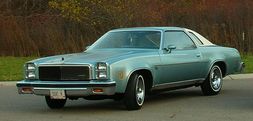



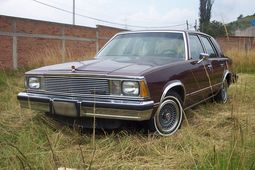

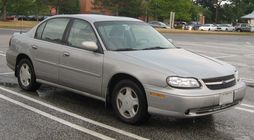
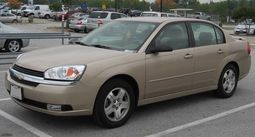

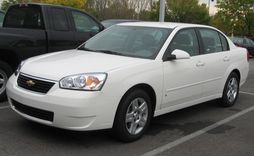
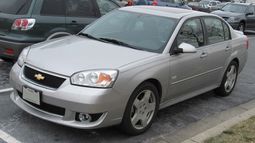

|